Updated: 13-Feb-2020
CNA (Compagnia Nazionale Aeronautica)
(Italy)
The "Cia. Nazionale Aeronautica ", started as an aviation school.
-Founded in 1920 by Count Giovanni Bonmartini.
-He built the Littoria airport in 1931 and thereafter he began with the construction of aircraft and engines.
-He made the C-2 with two opposed cylinders that gave 28 CV at 3,000 rpm and 32 CV at 3,600 rpm. This engine was made between 1933 and 1935.
-The C-II two-cylinder gave 38 CV at 2,700 rpm, and was built from 1937 to 1941.
-The C-IIbis is similar and known as a slightly larger variant of the C-2.
-Other sources say that the C-2 with 40 CV was mounted on the Alaparma AM.9.
-We consider that it is the C-IIbis that gave 38/40 CV, which is similar to the C-2.
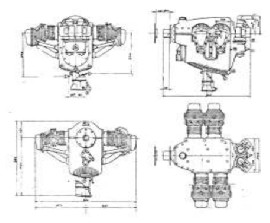
"D-4S measurements"
-By 1940 they made the air-cooled D-4 for tourism aviation. It delivered 60 CV.
-The lower crankcase was shaped like a cowl and contained the distribution and oil pump controls.
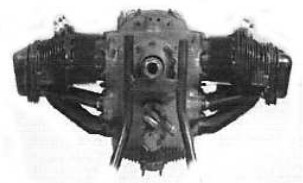
"CNA D-4 in Turin"
-It is the Compagnia Nazionale Aeronautica. After the author's trip to Turin, he brought some data about this company and its production that we mention hereafter:
-The C-7 of 1932, a radial engine with 7 cylinders, gave 170 CV.
-The C-X of the same year, a 12-cylinders radial, gave 240 CV.
-The C-VI with six inverted inline cylinders appears in 1933. It gave 150 CV.
-The C-VI IRC-43 version of 1935 maintained the 150 CV at 4,300 meters (14,108 ft) of altitude.
-The C-4, an inverted inline four-cylinder with gear, gave 90 CV at 4,800 rpm. This engine was made in the 1930's.
-In 1938 there was the air-cooled, horizontally opposed, two-cylinder, low power engine that gave 38 CV. The same counts for the C2 of the year 1943.
-The D-4 was made in 1942. It had four horizontally-opposed cylinders and gave 60 CV at 2,100 rpm.

"CNA, D-4"
-The VIII engine was an inverted V-8 that gave 310 CV at 2,500 rpm. It was supercharged so that it gave the power at 1,000 meters (3281 ft) of altitude.
-We have shown you the D-4 at the Polytechnic of Turin. Another one is shown below.

"Photo by M.Rickler, D-4"
-The D-4 gave way to the D-4S. The 60 CV was delivered at 2,100 rpm. It was built between 1940 and 1951. This engine had double ignition.
-As a curiosity, the oil contained in the large crankcase sump gave it an autonomy of 25 Hrs. This eliminated the external deposits and ducts. Seen in Etabeta, Meteor, etc.
-The CNA, L2 model giving 38 CV flew in the Partenavia P-53.
-But the most interesting engine of CNA was the C-4, also known as Type 4.
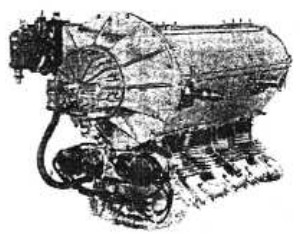
"CNA, C-4"
-It had 4 inverted cylinders and was supercharged by a centrifugal compressor.
-CNA's shield, emblem or logo has been located. Certainly beautiful. The letters CNA are distributed around it: the "C" at 9 o'clock, the "N" at 6 o'clock and the "A" at 3 o'clock, situation of these hours - and letters - in the sphere of a clock.
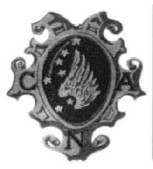
"CNA logo"
From Appendix 9: The "Compagnia Nazionale Aeronautica" made several engines, see main text, among them the C-II.
-One of these engines was exhibited at the Fiera Milano in 1935.

“CNA C-II, sobre pedestal” (PeT=LBC)
-The C-II had two horizontally-opposed cylinders. The photo is taken half a quarter to the left from behind and we see the valve push rods in such a way that we guess the chambers are hemispherical.
-The oil tank is very low and the carburetor (white) is even lower.
-It gave 38 CV at 2,700 rpm.
From Appendix 10: We have two new photographs of the D-4 or D-4S engine.
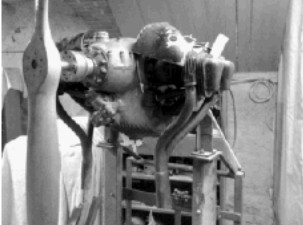
"CNA with propeller on a bench"

"CNA 60 CV on a stand"
-Ilustrations with different views CNA engine views. First the two-cylinder boxer.
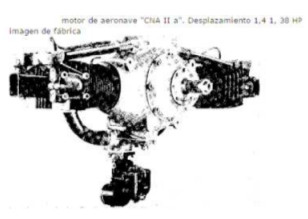
“CNA IIa, 38 CV”
-And the four-cylinder boxer, D.4 model. Its details are mentioned in the main text.
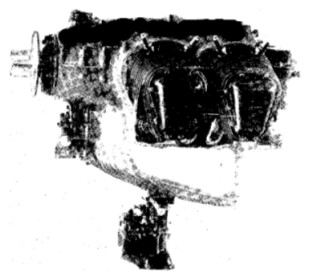
"CNA, D-4 model”
Engines of CNA (Compagnia Nazionale Aeronautica)
Model: C-2 (C-II, C-IIbis) 2 twin-flat
Arquitecture: 2-cylinder Horizontally opposed
Cooling:
Total Displacement:
Bore / Stroke:
Power: 28 / 32 CV @ 3000 / 3800 rpm
Weight:
This engine was made between 1933 and 1935.
The C-II two-cylinder gave 38 CV at 2,700 rpm, and was built from 1937 to 1941.
The C-IIbis is similar and known as a slightly larger variant of the C-2.

"CNA C-II, on stand" (PeT)
Model: C-4, 4 cils. en linea inv.
Arquitecture: 4-cylinder In line inverted
Cooling:
Total Displacement:
Bore / Stroke:
Power: 90 CV @ 4800 rpm
Weight:
This engine was geared and it was made in the 1930's.

"CNA, C-4"
Model: C-7, radial 7 cils., 170 CV
Arquitecture: 7-cylinder Radial
Cooling:
Total Displacement:
Bore / Stroke:
Power: 170 CV @ rpm
Weight:
Model: C-VI, 6 cils. en linea
Arquitecture: 6-cylinder In line inverted
Cooling:
Total Displacement:
Bore / Stroke:
Power: 150 CV @ rpm
Weight:
It appears in 1933.
The C-VI IRC-43 version from 1935 maintained the 150 CV at 4,300 meters (14,108 ft) of altitude.
Model: C-VIII, 8 cils. en V
Arquitecture: 8-cylinder V-Engine
Cooling:
Total Displacement:
Bore / Stroke:
Power: 310 CV @ 2500 rpm
Weight:
The VIII engine was supercharged so that it gave its power at 1,000 meters (3281 ft) of altitude.
Model: C-X, radial 12 cils.
Arquitecture: 12-cylinder Radial
Cooling:
Total Displacement:
Bore / Stroke:
Power: 240 CV @ rpm
Weight:
Model: D-4, 4 cils. boxer
Arquitecture: 4-cylinder Horizontally opposed
Cooling: Air
Total Displacement:
Bore / Stroke:
Power: 60 CV @ 2100 rpm
Weight:
It was destined for tourism aviation. The lower crankcase was shaped like a cowl and contained the distribution and oil pump controls.

"Picture by M.Rickler, CNA D-4"
Model: D-4S, 60 CV
Arquitecture: 4-cylinder Horizontally opposed
Cooling:
Total Displacement:
Bore / Stroke:
Power: 60 CV @ 2100 rpm
Weight:
The D-4 gave way to the D-4S. It was built between 1940 and 1951. This engine had double ignition.

"D-4S measurements"
Model: L-2, 38 CV
Arquitecture:
Cooling:
Total Displacement:
Bore / Stroke:
Power: 38 CV @ rpm
Weight:
The CNA, L2 model giving 38 CV flew in the Partenavia P-53.


